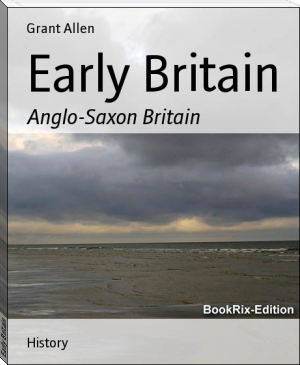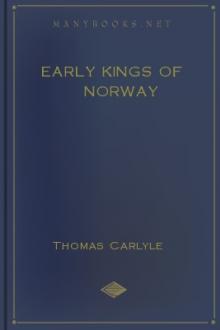Early Britain by Grant Allen (books recommended by bts TXT) 📕

- Author: Grant Allen
Book online «Early Britain by Grant Allen (books recommended by bts TXT) 📕». Author Grant Allen
Bill of Selsey, then, as its title imports, a separate island girt round by the tidal sea: their capital and, in days after the Norman conquest, their cathedral was at Cissan-ceaster, the Roman Regnum, now Chichester: while the third name survives in the modern village of Lancing, near Shoreham. The Saxons at once fought the natives "and offslew many Welsh, and drove some in flight into the wood that is named Andredes-leag," now the Weald of Kent and Sussex. A little colony thus occupied the western half of the modern county: but the eastern portion still remained in the hands of the Welsh. For awhile the great Roman fortress of Anderida (now Pevensey) held out against the invaders; until in 491 "Ælle and Cissa beset Anderida, and offslew all that were therein; nor was there after even one Briton left alive." All Sussex became a single Saxon kingdom, ringed round by the great forest of the Weald. Here again the obviously unhistorical character of the main facts throws the utmost doubt upon the nature of the details. Yet, in this case too, the central idea itself is likely enough,-–that the South Saxons first occupied the solitary coast islet of Selsey; then conquered the fortress of Regnum and the western shore as far as Eastbourne; and finally captured Anderida and the eastern half of the county up to the line of the Romney marshes.
Even more improbable is the story of the Saxon settlement on the more distant portion of the south coast. In 495 "came twain aldermen to Britain, Cerdic and Cynric his son, with five ships, at that place that is cleped Cerdices ora, and fought that ilk day with the Welsh." Clearly, the name of Cerdic may be invented solely to account for the name of the place: since we see by the sequel that the English freely imagined such personages as pegs on which to hang their mythical history.[1] For, six years later, one Port landed at Portsmouth with two ships, and there slew a Welsh nobleman. But we know positively that the name of Portsmouth comes from the Latin _Portus_; and therefore Port must have been simply invented to explain the unknown derivation. Still more flagrant is the case of Wihtgar, who conquered the Isle of Wight, and was buried at Wihtgarasbyrig, or Carisbrooke. For the origin of that name is really quite different: the Wiht-ware or Wiht-gare are the men of Wight, just as the Cant-ware are the men of Kent: and Wiht-gara-byrig is the Wight-men's-bury, just as Cant-wara-byrig or Canterbury is the Kent-men's-bury. Moreover, a double story is told in the Chronicle as to the original colonisation of Wessex; the first attributing the conquest to Cerdic and Cynric, and the second to Stuf and Wihtgar.
[1] Cerdic is apparently a British rather than an English
name, since Bæda mentions a certain "Cerdic, rex Brettonum."
This may have been a Caradoc. Perhaps the first element in
the names Cerdices ora, Cerdices ford, &c., was older than
the English conquest. The legends are invariably connected
with local names.
The only other existing legend refers to the great English kingdom of Northumbria: and about it the English Chronicle, which is mainly West Saxon in origin, merely tells us in dry terms under the year 547, "Here Ida came to rule." There are no details, even of the meagre kind, vouchsafed in the south; no account of the conquest of the great Roman town of York, or of the resistance offered by the powerful Brigantian tribes. But a fragment of some old Northumbrian tradition, embedded in the later and spurious Welsh compilation which bears the name of Nennius, tells us a not improbable tale–that the first settlement on the coast of the Lothians was made as early as the conquest of Kent, by Jutes of the same stock as those who colonised Thanet. A hundred years later, the Welsh poems seem to say, Ida "the flame-bearer," fought his way down from a petty principality on the Forth, and occupied the whole Northumbrian coast, in spite of the stubborn guerilla warfare of the despairing provincials. Still less do we learn about the beginnings of Mercia, the powerful English kingdom which occupied the midlands; or about the first colonisation of East Anglia. In short, the legends of the settlement, unhistorical and meagre as they are, refer only to the Jutish and Saxon conquests in the south, and tell us nothing at all about the origin of the main English kingdoms in the north. It is important to bear in mind this fact, because the current conceptions as to the spread of the Anglo-Saxon race and the extermination of the native Welsh are largely based upon the very limited accounts of the conquest of Kent and Sussex, and the mournful dirges of the Welsh monks or bards.
It seems improbable, however, that the north-eastern coast of Britain, naturally exposed above every other part to the ravages of northern pirates, and in later days the head-quarters of the Danish intruders in our island, should so long have remained free from English incursions. If the Teutonic settlers really first established themselves here a century later than their conquest of Kent, we can only account for it by the supposition that York and the Brigantes, the old metropolis of the provinces, held out far more stubbornly and successfully than Rochester and Anderida, with their very servile Romanised population. But even the words of the Chronicle do not necessarily imply that Ida was the first king of the Northumbrians, or that the settlement of the country took place in his days.[2] And if they did, we need not feel bound to accept their testimony, considering that the earliest date we can assign for the composition of the chronicle is the reign of Ælfred: while Bæda, the earlier native Northumbrian historian, throws no light at all upon the question. Hence it seems probable that Nennius preserves a truthful tradition, and that the English settled in the region between the Forth and the Tyne, at least as early as the Jutes settled in Kent or the Saxons along the South Coast, from Pevensey Bay to Southampton Water.
[2] A remarkable passage in the Third Continuator of
Florence mentions Hyring as the first king of Bernicia,
followed by Woden and five other mythical personages, before
Ida. Clearly, this is mere unhistorical guesswork on the
part of the monk of Bury; but it may enclose a genuine
tradition so far as Hyring is concerned.
If, then, we leave out of consideration the etymological myths and numerical absurdities of the English or Welsh legends, and look only at the facts disclosed to us by the subsequent condition of the country, we shall find that the early Anglo-Saxon settlements took place somewhat after this wise. In the extreme north, the English apparently did not care to settle in the rugged mountain country between Aberdeen and Edinburgh, inhabited by the free and warlike Picts. But from the Firth of Forth to the borders of Essex, a succession of colonies, belonging to the restricted English tribe, occupied the whole provincial coast, burning, plundering, and massacring in many places as they went. First and northernmost of all came the people whom we know by their Latinised title of Bernicians, and who descended upon the rocky braes between Forth and Tyne. These are the English of Ida's kingdom, the modern Lothians and Northumberland. Their chief town was at Bebbanburh, now Bamborough, which Ida "timbered, and betyned it with a hedge." Next in geographical order stood the people of Deira, or Yorkshire, who occupied the rich agricultural valley of the Ouse, the fertile alluvial tract of Holderness, and the bleak coast-line from Tyne to Humber. Whether they conquered the Roman capital of York, or whether it made terms with the invaders, we do not know; but it is not mentioned as the chief town of the English kings before the days of Eadwine, under whom the two Northumbrian chieftainships were united into a single kingdom. However, as Eadwine assumed some of the imperial Roman trappings, it seems not unlikely that a portion at least of the Romanised population survived the conquest. The two principalities probably spread back politically in most places as far as the watershed which separates the basins of the German Ocean and the Irish Sea; but the English population seems to have lived mainly along the coast or in the fertile valley of the Ouse and its tributaries; for Elmet and Loidis, two Welsh principalities, long held out in the Leeds district, and the people of the dales and the inland parts, as we shall see reason hereafter to conclude, even now show evident marks of Celtic descent. Together the two chieftainships were generally known by the name of Northumberland, now confined to their central portion; but it must never be forgotten that the Lothians, which at present form part of modern Scotland, were originally a portion of this early English kingdom, and are still, perhaps, more purely English in blood and speech than any other district in our island.
From Humber to the Wash was occupied by a second English colony, the men of Lincolnshire, divided into three minor tribes, one of which, the Gainas, has left its name to Gainsborough. Here, again, we hear nothing of the conquest, nor of the means by which the powerful Roman colony of Lincoln fell into the hands of the English. But the town still retains its Roman name, and in part its Roman walls; so that we may conclude the native population was not entirely exterminated.
East Anglia, as its name imports, was likewise colonised by an English horde, divided, like the men of Kent, into two minor bodies, the North Folk and the South Folk, whose names survive in the modern counties of Norfolk and Suffolk. But in East Anglia, as in Yorkshire, we shall see reason hereafter to conclude that the lower orders of Welsh were largely spared, and that their descendants still form in part the labouring classes of the two counties. Here, too, the English settlers probably clustered thickest along the coast, like the Danes in later days; and the great swampy expanse of the Fens, then a mere waste of marshland tenanted by beavers and wild fowl, formed the inland boundary or mark of their almost insular kingdom.
The southern half of the coast was peopled by Englishmen of the Saxon and Jutish tribes. First came the country of the East Saxons, or Essex, the flat land stretching from the borders of East Anglia to the estuary of the Thames. This had been one of the most thickly-populated Roman regions, containing the important stations of Camalodunum, London, and Verulam. But we know nothing, even by report, of its conquest. Beyond it, and separated by the fenland of the Lea, lay the outlying little principality of Middlesex. The upper reaches of the Thames were still in the hands of the Welsh natives, for the great merchant city of London blocked the way for the pirates to the head-waters of the river.
On the south side of the estuary lay the Jutish principalities of East and West Kent, including the strong Roman posts of Rhutupiæ, Dover, Rochester, and Canterbury. The great forest of the Weald and the Romney Marshes separated them from Sussex; and the insular positions of Thanet and Sheppey had always special attractions for the northern pirates.
Beyond the marshes, again, the strip of southern shore, between the downs and the sea, as far as Hayling
Even more improbable is the story of the Saxon settlement on the more distant portion of the south coast. In 495 "came twain aldermen to Britain, Cerdic and Cynric his son, with five ships, at that place that is cleped Cerdices ora, and fought that ilk day with the Welsh." Clearly, the name of Cerdic may be invented solely to account for the name of the place: since we see by the sequel that the English freely imagined such personages as pegs on which to hang their mythical history.[1] For, six years later, one Port landed at Portsmouth with two ships, and there slew a Welsh nobleman. But we know positively that the name of Portsmouth comes from the Latin _Portus_; and therefore Port must have been simply invented to explain the unknown derivation. Still more flagrant is the case of Wihtgar, who conquered the Isle of Wight, and was buried at Wihtgarasbyrig, or Carisbrooke. For the origin of that name is really quite different: the Wiht-ware or Wiht-gare are the men of Wight, just as the Cant-ware are the men of Kent: and Wiht-gara-byrig is the Wight-men's-bury, just as Cant-wara-byrig or Canterbury is the Kent-men's-bury. Moreover, a double story is told in the Chronicle as to the original colonisation of Wessex; the first attributing the conquest to Cerdic and Cynric, and the second to Stuf and Wihtgar.
[1] Cerdic is apparently a British rather than an English
name, since Bæda mentions a certain "Cerdic, rex Brettonum."
This may have been a Caradoc. Perhaps the first element in
the names Cerdices ora, Cerdices ford, &c., was older than
the English conquest. The legends are invariably connected
with local names.
The only other existing legend refers to the great English kingdom of Northumbria: and about it the English Chronicle, which is mainly West Saxon in origin, merely tells us in dry terms under the year 547, "Here Ida came to rule." There are no details, even of the meagre kind, vouchsafed in the south; no account of the conquest of the great Roman town of York, or of the resistance offered by the powerful Brigantian tribes. But a fragment of some old Northumbrian tradition, embedded in the later and spurious Welsh compilation which bears the name of Nennius, tells us a not improbable tale–that the first settlement on the coast of the Lothians was made as early as the conquest of Kent, by Jutes of the same stock as those who colonised Thanet. A hundred years later, the Welsh poems seem to say, Ida "the flame-bearer," fought his way down from a petty principality on the Forth, and occupied the whole Northumbrian coast, in spite of the stubborn guerilla warfare of the despairing provincials. Still less do we learn about the beginnings of Mercia, the powerful English kingdom which occupied the midlands; or about the first colonisation of East Anglia. In short, the legends of the settlement, unhistorical and meagre as they are, refer only to the Jutish and Saxon conquests in the south, and tell us nothing at all about the origin of the main English kingdoms in the north. It is important to bear in mind this fact, because the current conceptions as to the spread of the Anglo-Saxon race and the extermination of the native Welsh are largely based upon the very limited accounts of the conquest of Kent and Sussex, and the mournful dirges of the Welsh monks or bards.
It seems improbable, however, that the north-eastern coast of Britain, naturally exposed above every other part to the ravages of northern pirates, and in later days the head-quarters of the Danish intruders in our island, should so long have remained free from English incursions. If the Teutonic settlers really first established themselves here a century later than their conquest of Kent, we can only account for it by the supposition that York and the Brigantes, the old metropolis of the provinces, held out far more stubbornly and successfully than Rochester and Anderida, with their very servile Romanised population. But even the words of the Chronicle do not necessarily imply that Ida was the first king of the Northumbrians, or that the settlement of the country took place in his days.[2] And if they did, we need not feel bound to accept their testimony, considering that the earliest date we can assign for the composition of the chronicle is the reign of Ælfred: while Bæda, the earlier native Northumbrian historian, throws no light at all upon the question. Hence it seems probable that Nennius preserves a truthful tradition, and that the English settled in the region between the Forth and the Tyne, at least as early as the Jutes settled in Kent or the Saxons along the South Coast, from Pevensey Bay to Southampton Water.
[2] A remarkable passage in the Third Continuator of
Florence mentions Hyring as the first king of Bernicia,
followed by Woden and five other mythical personages, before
Ida. Clearly, this is mere unhistorical guesswork on the
part of the monk of Bury; but it may enclose a genuine
tradition so far as Hyring is concerned.
If, then, we leave out of consideration the etymological myths and numerical absurdities of the English or Welsh legends, and look only at the facts disclosed to us by the subsequent condition of the country, we shall find that the early Anglo-Saxon settlements took place somewhat after this wise. In the extreme north, the English apparently did not care to settle in the rugged mountain country between Aberdeen and Edinburgh, inhabited by the free and warlike Picts. But from the Firth of Forth to the borders of Essex, a succession of colonies, belonging to the restricted English tribe, occupied the whole provincial coast, burning, plundering, and massacring in many places as they went. First and northernmost of all came the people whom we know by their Latinised title of Bernicians, and who descended upon the rocky braes between Forth and Tyne. These are the English of Ida's kingdom, the modern Lothians and Northumberland. Their chief town was at Bebbanburh, now Bamborough, which Ida "timbered, and betyned it with a hedge." Next in geographical order stood the people of Deira, or Yorkshire, who occupied the rich agricultural valley of the Ouse, the fertile alluvial tract of Holderness, and the bleak coast-line from Tyne to Humber. Whether they conquered the Roman capital of York, or whether it made terms with the invaders, we do not know; but it is not mentioned as the chief town of the English kings before the days of Eadwine, under whom the two Northumbrian chieftainships were united into a single kingdom. However, as Eadwine assumed some of the imperial Roman trappings, it seems not unlikely that a portion at least of the Romanised population survived the conquest. The two principalities probably spread back politically in most places as far as the watershed which separates the basins of the German Ocean and the Irish Sea; but the English population seems to have lived mainly along the coast or in the fertile valley of the Ouse and its tributaries; for Elmet and Loidis, two Welsh principalities, long held out in the Leeds district, and the people of the dales and the inland parts, as we shall see reason hereafter to conclude, even now show evident marks of Celtic descent. Together the two chieftainships were generally known by the name of Northumberland, now confined to their central portion; but it must never be forgotten that the Lothians, which at present form part of modern Scotland, were originally a portion of this early English kingdom, and are still, perhaps, more purely English in blood and speech than any other district in our island.
From Humber to the Wash was occupied by a second English colony, the men of Lincolnshire, divided into three minor tribes, one of which, the Gainas, has left its name to Gainsborough. Here, again, we hear nothing of the conquest, nor of the means by which the powerful Roman colony of Lincoln fell into the hands of the English. But the town still retains its Roman name, and in part its Roman walls; so that we may conclude the native population was not entirely exterminated.
East Anglia, as its name imports, was likewise colonised by an English horde, divided, like the men of Kent, into two minor bodies, the North Folk and the South Folk, whose names survive in the modern counties of Norfolk and Suffolk. But in East Anglia, as in Yorkshire, we shall see reason hereafter to conclude that the lower orders of Welsh were largely spared, and that their descendants still form in part the labouring classes of the two counties. Here, too, the English settlers probably clustered thickest along the coast, like the Danes in later days; and the great swampy expanse of the Fens, then a mere waste of marshland tenanted by beavers and wild fowl, formed the inland boundary or mark of their almost insular kingdom.
The southern half of the coast was peopled by Englishmen of the Saxon and Jutish tribes. First came the country of the East Saxons, or Essex, the flat land stretching from the borders of East Anglia to the estuary of the Thames. This had been one of the most thickly-populated Roman regions, containing the important stations of Camalodunum, London, and Verulam. But we know nothing, even by report, of its conquest. Beyond it, and separated by the fenland of the Lea, lay the outlying little principality of Middlesex. The upper reaches of the Thames were still in the hands of the Welsh natives, for the great merchant city of London blocked the way for the pirates to the head-waters of the river.
On the south side of the estuary lay the Jutish principalities of East and West Kent, including the strong Roman posts of Rhutupiæ, Dover, Rochester, and Canterbury. The great forest of the Weald and the Romney Marshes separated them from Sussex; and the insular positions of Thanet and Sheppey had always special attractions for the northern pirates.
Beyond the marshes, again, the strip of southern shore, between the downs and the sea, as far as Hayling
Free e-book «Early Britain by Grant Allen (books recommended by bts TXT) 📕» - read online now
Similar e-books:





Comments (0)